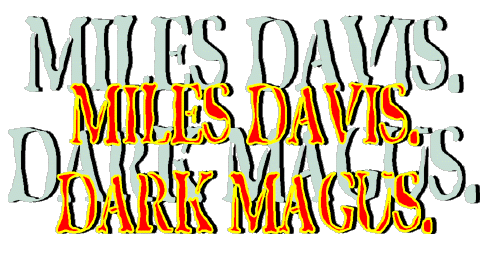Miles
Davis and his band played on Wednesday night for more then two
hours without a pause. I found the first hour or so red hot , but in
the second was frequently bored. This may not have been due to a deterioration
in the music. A 10 minute respite could have made all the difference.
Even those who knew that Davis does not always play long solos nursed
a hope that he might feel so inclined. This possibility evaporated when
some one called "play your horn ".
Davis said something into the microphone attached to his trumpet. It
sounded like "I don't play to orders"
Nevertheless he continued in apparently good spirits. In fact he did
play a lot of trumpet but never for long. He added shorty lines to the
ensembles and prompted changes with a brief phrase , conducting as it
were with the trumpet. Some of his lines were beautiful , but of course
they were there and gone. The concert was an intense rhythmic onslaught
with quiet interludes in which Davis would stroll to the front of the
stage , followed by a spotlight and playing his trumpet at the ground
, like a very casual water diviner. Some of these interludes yielded
a perfectly cast and beautifully modulated passage of muted trumpet,
but it did seem that less was just not quite good enough. Similarly
his trumpet would begin to sing and would seem to be on the point of
soaring and then stop.
But what Miles Davis
is presenting these days is largely percussion based. On this base are
built structures that can sound highly arranged, but in fact allow for
considerable internal freedom. A young woman Davis introduced as Marilyn
had command of a cage of hanging bells and cymbals as well as floor
drums . The interaction between her and drummer Ricky
Wellman was the most consistently exciting aspect of the concert.
Saxophonist Kenny Garrett played
much longer solos than Miles and on two occasions cooked up a real fire,
bringing the band to a controlled frenzy. Foley
also took a number of solos on a bass that was tuned up a minor seventh
to sound very like a guitar . His first effort , on the blues, was a
scorcher , calling up shades of Buddy Guy
and Jimmy Hendrix. His subsequent work
sounded to me like rather conventional rock guitar , interspersed with
moments of special interest - particularly with his use of feedback.
The sound was at
precisely the right volume , very well mixed. Somehow this , coupled
with the fact that a number of tunes were given similar treatments to
those on recent recordings, gave the effect of watching a video. The
sometimes disembodied sound of the two synthesisers, especially when
they used the voice sample - which I rather dislike, heightened this
effect. A concert that will be argued about for some time to come .
Gail

